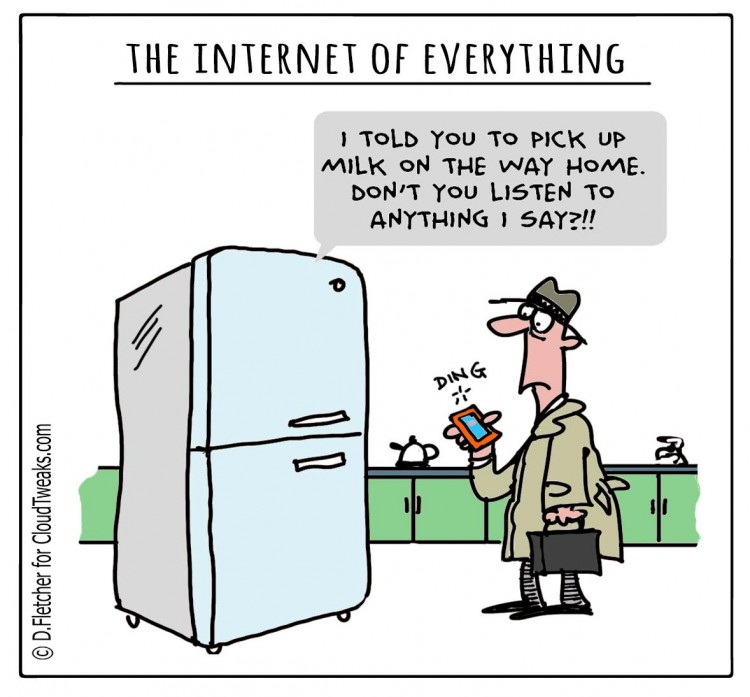Just as the Industrial Revolution changed the relationship between humans and work, the rise of the Internet of Things promises to create a fundamental shift in the way companies and their employees operate. This leap forward won’t happen just because everything from coffee cups to light fixtures has sensors now — it will happen because the information we receive from those sensors augments our reality.
We’re approaching an era when all the sensors around us are connected, feeding and receiving data from one another and improving our ability to understand and interact with that information. It’s the difference between receiving information about traffic and having the GPS automatically update the map in real time as we drive.
Understanding this, it should be no surprise that the real-world impact of the IoT occurs at the edge between the physical and the digital world.

Any physical movement, like preparing boxes for shipment, always has consequences beyond the physical space. The boxes might be late, overstuffed, or broken in transit — all of which impacts shift schedules, time slots, budgeting, and more. The real innovation of the IoT isn’t in the physical realm or the digital realm but in the space where they meet.
As this integration grows, the future of the IoT will become even more intertwined with automation and Machine Learning. We as humans won’t be able to handle all the data they collect, and we shouldn’t be expected to. It doesn’t matter to me how long a traffic jam is — it matters when and how I can get to my next appointment.
The same is true for many professions. Nurses don’t need to know the number of accidents on the road as much as when the next patients will arrive and what care they’ll require. Shift leaders don’t need to know the temperatures of the machines, but they do need to know when to take action to keep production moving.
As the machines around us evolve, so do we, and in turn our relationship to them. Every time we increase the number of connections between ourselves and our machines, the evolution of work has taken a tremendous step forward. Mass manufacturing created a network of hands and allowed productivity to skyrocket. The internet connected us to one another, pooling our resources and creativity to overcome the limitations of cognition and memory.
Over the coming years, we’ll see significant advances in AI and chatbots assisting us in everyday tasks. But an assistant is only as good as the data upon which it can make decisions. With the IoT, we exponentially increase not only the amount of data, but also the number of sources from which the data is drawn, giving bots more context with which to make better decisions.
Of course, this revolution won’t be without casualties. As machines evolve to take on increasingly complex tasks, many workers may suddenly find their positions become redundant.
Historian Yuval Noah Harari believes that this disparity will eventually create a class of the “economically useless” as the rise of AI eliminates the need for thousands of positions. While this shift won’t happen overnight, business and societal leaders will need to be cognizant of what this will mean for the next generation.
Transportation has already started to see this change and will continue to evolve as the technology does. Who needs a car when there’s Uber? Who needs a driver when there are self-driving cars? Better yet, why drive at all if you need to meet someone who is scheduled to be in the building next door tomorrow?
Changes on the scale of machine learning, fed by the IoT, alter everything about how we live, not just how we work. Doctors will appreciate getting more patient data to make better decisions. Patients will appreciate when their medical wearables tell them they just need more fluids and a good night’s sleep rather than a trip to the ER.
While advancements in machine work will advance means of production, leaders in the future will be primarily concerned with the human element. How can managers today prepare to lead an IoT-integrated workforce?
1. Reach your people. For every advancement, the first question should be, “How does this help real people?” Remember the example of the traffic jam — you don’t need to know how long it is. You just need to know what it means for your route to your destination. If you don’t have a path to reach your employees now, you don’t have the foundation to take advantage of the IoT. Focus on reaching people first — both physically (devices) as well as emotionally (impact).
2. Educate and enjoy. People are often skeptical about big changes, so bring them into the conversation and show them how this will benefit them directly. Empower people to leverage their own data, like work schedule, pay slips, calls made, etc. The more they see the benefits firsthand, the more prepared they’ll be to make the change.
3. Start on basic bots. HR is an easy department to begin small. Little things like vacation reminders, benefits enrollment surveys, and opportunities to submit questions for a town hall meeting can all be handled by bots, freeing up the valuable time of your trained professionals.
4. Use cases, not buzzwords. The IoT isn’t unique. It’s the same as big data, machine learning, AI, bots, etc. It all comes down to collecting more data and using it more effectively, so don’t make things more complicated than necessary. Focus on the things you want to improve within your organization, such as employee engagement, productivity, service levels, and inventory. The process defines the tool, not the other way around.
The evolution of work will be here before we know it, and the IoT will only continue to grow. Don’t be caught without a plan. Know the effects the IoT will have on your business so you can make a smooth transition to better workflows, happier employees, and a stronger company overall.
By Daniel Kraft





